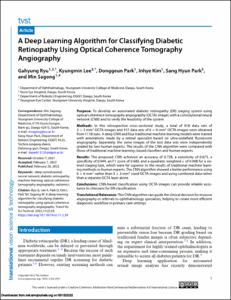Department of Robotics and Mechatronics Engineering
Medical Image & Signal Processing Lab
1. Journal Articles
A Deep Learning Algorithm for Classifying Diabetic Retinopathy Using Optical Coherence Tomography Angiography
- Title
- A Deep Learning Algorithm for Classifying Diabetic Retinopathy Using Optical Coherence Tomography Angiography
- Author(s)
- Ryu, Gahyung ; Lee, Kyungmin ; Park, Donggeun ; Kim, Inhye ; Park, Sang Hyun ; Sagong, Min
- Issued Date
- 2022-02
- Citation
- Translational Vision Science & Technology, v.11, no.2
- Type
- Article
- Author Keywords
- deep convolutional neural network ; diabetic retinopathy ; machine learning ; optical coherence tomography angiography ; radiomics
- Keywords
- FLUORESCEIN ANGIOGRAPHY ; PERIPHERAL LESIONS ; RANIBIZUMAB ; CLASSIFICATION ; NONPERFUSION ; SEVERITY ; LASER
- ISSN
- 2164-2591
- Abstract
- Purpose: To develop an automated diabetic retinopathy (DR) staging system using optical coherence tomography angiography (OCTA) images with a convolutional neural network (CNN) and to verify the feasibility of the system. Methods: In this retrospective cross-sectional study, a total of 918 data sets of 3 x 3 mm(2) OCTA images and 917 data sets of 6 x 6 mm(2) OCTA images were obtained from 1118 eyes. A deep CNN and four traditional machine learning models were trained with annotations made by a retinal specialist based on ultra-widefield fluorescein angiography. Separately, the same images of the test data sets were independently graded by two human experts. The results of the CNN algorithm were compared with those of traditional machine learning-based classifiers and human experts. Results: The proposed CNN achieved an accuracy of 0.728, a sensitivity of 0.675, a specificity of 0.944, an F1 score of 0.683, and a quadratic weighted kappa of 0.908 for a six-level staging task, which were far superior to the results of traditional machine learning-methods or human experts. The CNN algorithm showed a better performance using 6 x 6 mm(2) rather than 3 x 3 mm(2) sized OCTA images and using combined data rather than a separate OCTA layer alone. Conclusions: CNN-based classification using OCTA images can provide reliable assistance to clinicians for DR classification. Translational Relevance: This CNN algorithm can guide the clinical decision for invasive angiography or referrals to ophthalmology specialists, helping to create more efficient diagnostic workflow in primary care settings.
- Publisher
- Association for Research in Vision and Ophthalmology
- Related Researcher
-
-
Park, Sang Hyun
- Research Interests 컴퓨터비전; 인공지능; 의료영상처리
-
- Files in This Item:
-
 기타 데이터 / 3.96 MB / Adobe PDF
download
기타 데이터 / 3.96 MB / Adobe PDF
download



